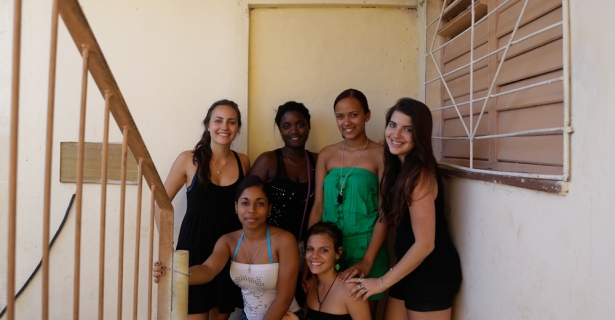Emily Bartlett is a senior (A14) majoring in International Relations and Nicola Pardy is a senior (A14) majoring in Political Science.
As mentioned earlier in this blog, the district of Alamar consists entirely of ex-soviet housing blocks—rows upon rows of gray concrete apartments that are totally identical architecturally. This total uniformity means that this is not the ideal place for two foreigners to get lost—but that we did. After various false leads (a ration shop did in fact exist in every “zone” of the neighborhood) and friendly but relatively unhelpful suggestions from the locals, we finally managed to find Carmen’s apartment after spotting a familiar dilapidated school bus in the parking lot.
After apologizing for our tardiness with a bunch of very wilted sunflowers, we set about taking formal portraits of Carmen and her friends. This would contrast the fly-on-the-wall style photography we had aimed for during our previous time with Carmen and her friends. We set up a studio in Carmen’s living room, where Nicola worked individually with each girl, while Emily conducted group interviews, chatting with the rest of the girls in Carmen’s room, asking them about their day-to-day lives, the ‘girl culture’ their neighborhood, and their goals and aspirations for the future.
It was great to speak to all the girls while they were together, as they relaxed more in a group and became much more eager to answer questions and expand on ideas independently. The dynamics between this group of girls, along with each young woman’s personality and role within it, became much more apparent to us.
Within this discussion, we learned about some aspects of girl culture particular to their context that surprised us. The girls explained that in their social circles, girls don’t drink or smoke—those are things reserved for the boys, and the girls who partake tend to get a bad reputation. Sexual relations, however, seemingly occur at a much younger age (for women) than is the norm in the U.S., and are discussed in a very frank and open manner.
When we discussed body image and appearances, we found that it was not a desire to be thin that pervaded their culture, but instead a desire to “have a body” or have curves. Apparently, it is the skinny girls—the “flacas”—who are taunted on the streets and at school, and who feel a lot of pressure to put on weight and fill out more. The intense importance of their Quinciniera—their 15th birthday party celebrations— became even more apparent as the girls explained that it was really their opportunity to be transformed and emerge as a “woman” instead of a girl. This transformation is represented physically by the girls first participation in cosmetic routines, such as getting their eyebrows waxed for the first time, starting to wear makeup, or shaving their legs.
After all the portraits had been taken and we had talked for about an hour and a half, the girls were eager to show us around their own homes and other parts of the neighborhood. As we walked through the streets the family ties and connections that created this strong community were obvious—each girl was yelling up to their mother or cousin and niece in the balcony above, and we were constantly introduced to relatives and friends as we walked past.
The day ended beautifully, with the girls leading us along the coastline near their neighborhood which, unbeknownst to us, was less than a mile from Carmen’s house. As the sun started to go down, the girls started to ask us questions about ourselves—where we were from, what we wanted to do, and what home was like. It was clear that they were just as curious about us as we were about them. We were truly sad to say goodbye to these remarkable girls, and really hope to come back and visit when they are even further along in their path to adulthood.

